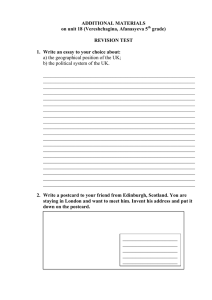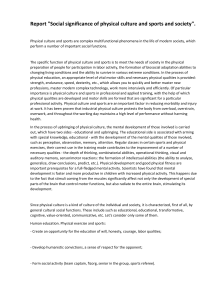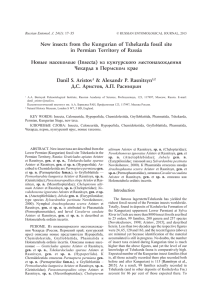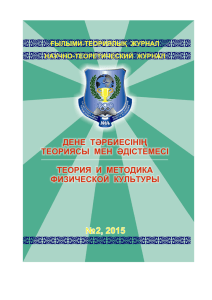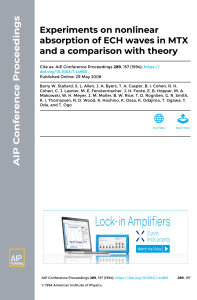3.Research and evaluation of the functional state of the cardiovascular, respiratory and autonomic nervous systems with the help of functional tests
реклама
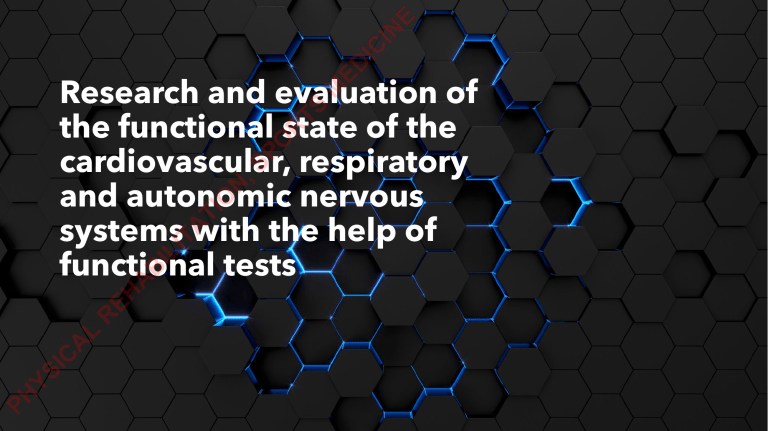
IC IN E M ED PH YS IC A L R EH A B IL IT A TI O N ,S PO R TS Research and evaluation of the functional state of the cardiovascular, respiratory and autonomic nervous systems with the help of functional tests L A YS IC PH ,S N O TI IL IT A B A R EH TS R PO IC IN E M ED Indices of physical development IC IN E R TS M ED QUETELET /Kettle`s/ INDEX PH YS IC A L R EH A B IL IT A TI O N ,S PO Quetelet Index - a body mass index (BMI), show the degree of obesity and evaluate the potential risk of developing the diseases associated with overweight. BMI=mass(kg)/height(m)2 (kg/m2) L A YS IC PH ,S N O TI IL IT A B A R EH TS R PO IC IN E M ED IC IN E PO R TS M ED BMI chart for adults IL IT A TI O N ,S This is a graph of BMI categories based on the World Health Organization data. PH YS IC A L R EH A B The dashed lines represent subdivisions within a major categorization IC IN E PO R TS M ED BMI BMI (kg/m2) from N ,S Category 15 TI O Very severely underweight Severely underweight 15 16 Underweight 16 18.5 Normal (healthy weight) 18.5 25 Overweight 25 30 Obese Class I (Moderately obese) 30 35 Obese Class II (Severely obese) 35 40 Obese Class III (Very severely obese) 40 IL IT A B A R EH L A YS IC PH to IC IN E ,S PO R TS M ED BMI O N Health Risk under 18.5 Low Risk (healthy range) 18.5 to 23 Moderate risk of developing heart disease, high blood pressure, stroke, diabetes 23 to 27.5 High risk of developing heart disease, high blood pressure, stroke, diabetes over 27.5 A L R EH A B IL IT A TI Risk of developing problems such as nutritional deficiency and osteoporosis YS IC PH BMI (kg/m2) IC IN E M ED O N ,S PO R TS Piniere’s index PH YS IC A L R EH A B IL IT A TI Piniere’s index - index characterizing the human body type. Calculated on the basis of a ratio of height, weight and circumference of thorax. DEVICE: heightmete, tape measure IC IN E M ED ,S PO PI = L – (P+T), R TS Piniere’s index TI O N L - body height (cm), IL IT A P - body weight (kg), R EH A B T - chest circumference (cm). A L Asthenics have more than 30, PH YS IC Hypersthenics - less than 10, Normosthenics - from 10 to 30 IC IN E PO R TS M ED Erismann Index (an index of the chest proportionality) O N ,S •EI = Q – L/2 R EH A B IL IT A TI EI - Erismann Index Q - circumference of thorax at rest (cm) L - body height (cm) PH YS IC A L Normal index: man - +5.8 cm and more woman - +3.3 cm and more IC IN E M ED Power Index PO R TS (power of hand) IL IT A TI O N ,S There is a certain dependency between body mass and muscle strength. Typically, the more muscle mass, the greater muscle strength: R EH A B [Power hand (kg) / body weight (kg)] x 100 PH YS IC A L Dynamometry of hand in average is 65-80% of body mass for men and 48-50% for women. IC IN E M ED TS R Power Index (power of back) TI O N ,S PO Index of muscle strength of the back = [back dynamometry (kg) / weight (kg)] x 100 IL IT A Low strength back - less than 175% of its weight, R EH A B Strength under average - from 175 to 190%, L The average force - from 190 to 210%, PH YS IC A The strength is above average - from 210 to 225%, A large force - more than 225% of weight. IC IN E PO R TS M ED Index of physical development proportionality IL IT A TI O N ,S Index of physical development proportionality = ( standing height - sitting height / sitting height) x 100 R EH A B The value of the index gives an indication of the relative leg length: less than 87% - a small length in relation to body length, A L 87-92% - in proportion to the physical development, PH YS IC more than 92% - a relatively large length of the legs. IC IN E TS M ED Vital index TI O N ,S PO R Vital index = VCL (ml) / body weight (kg) R EH A B IL IT A VCL – vital capacity of lungs The higher index mean the better developed the respiratory function of the chest. PH YS IC A L The average value of the index for men - 65-70 ml / kg for women - 55-60 ml / kg for athletes - 75-80 ml / kg for female athletes - 65-70 ml / kg. IC IN E R TS M ED Basal metabolism Index N ,S PO Basic metabolism - the amount of calories that the body burns to maintain life in a state of rest (respiration, metabolism). IL IT A TI O It does not include physical activity, working/occupational activity. PH YS IC A L R EH A B This metabolism takes 60-75% of calories expended by the organism. Physical activity (movement and training) - takes 15 30% of calories, and the thermal effect of food (calories burned during the digestion process) is 10% of the total calories burned daily. Basal metabolic rate is directly related to the height and weight. IC IN E PO R TS M ED Factors affecting the basal metabolism A L R EH A B IL IT A TI O N ,S 1) Gender: Men value of the Basal metabolism is higher than women`s (more muscle mass). 2) Body Structure: Muscle mass is more active than fat mass and requires more energy. 3) Weight: The higher weight mean the greater surface of the body and more heat output (it increase the value of Basal metabolism. PH YS IC 4) Height: according to the law, higher growth increases the Basal metabolism. IC IN E R TS M ED Factors affecting the basal metabolism (2) R EH A B IL IT A TI O N ,S PO 5) Age: Infants has higher basal metabolic rate. With age, the basal metabolic rate slows down. 6) Sport and physical activity: a systematic load helps to improve health, burn fat, increase muscle mass, which will lead to acceleration of the basic metabolism. 7) Meals: Fasting or a sharp decrease in calories will not help to lose weight. But can ruin the health and slow down metabolism. PH YS IC A L BMR is also affected by macronutrient intake: fats increase BMR by 5% carbohydrates increase BMR by 5-10% proteins increase BMR by 20 - 30% IC IN E PO R TS M ED Basal metabolism rate. Mifflin-San Geor formula. ,S STEP 1 IL IT A TI O N Man: BMR = 10 x W + 6,25 x H – 5 x A + 5 R EH A B Woman: BMR = 10 x W + 6,25 x H – 5 x A – 161 PH YS IC A L W - body weight in kg H - height in cm A - age IC IN E R TS M ED Basal metabolism rate. Mifflin-San Geor formula. (2) ,S PO STEP 2 O N BMR*ACTIVITY COEFFICIENT=DAILY ENERGY NEEDS PH YS IC A L R EH A B IL IT A TI If you want to lose weight, you need to take in fewer calories, and vice versa, if you want to gain weight, you need to take in more calories. Activity coefficient: passive type - minimal or no physical activity, multiply BMR by 1.2. minimally active type – workout 1-3 times a week, 1.375. moderately active type – workout 3-5 times a week, 1.55. active type – workout 5-6 times a week, 1.725. overly active type - for professional athletes or workouts 6-7 times a week, or a physically demanding job, 1.9. IC IN E IL IT A TI O N ,S PO R TS M ED Evaluation of the functional state and adaptability to the load PH YS IC A L R EH A B FUNCTIONAL TESTS IC IN E R TS M ED Functional tests are dosed loads that allow to determine the functional state of the human organism PH YS IC A L R EH A B IL IT A TI O N ,S PO Requirements to the functional tests: 1. The test should be a standard and reliable (able to be trusted, give a realistic result); 2. The test must be informative and valid (validity - is the accuracy of the parameter); 3. The test should be stressful (should cause changes in the testing system); 4. The test should match loads in the usual conditions (should corresponds to the physical capabilities of a person); 5. The test must be objective and harmless. IC IN E R TS M ED Indications for functional tests ,S PO 1. Testing of the functional state of the cardio - vascular, respiratory and other systems of the body of the healthy and sick people ; TI O N 2. Testing the physical condition (state) in sports, testing influence of physical training and physical therapy; IL IT A 3. Assessment of occupational suitability; B 4. Assessment the effectiveness of training and rehabilitation programs. R EH A 5. Evaluation of adaptability to a given load; 6. Evaluation of physical working capacity and fitness level; PH YS IC A L 7. Identifying changes in the cardio - vascular and other systems and processes of adaptation to the loads from one stage to another; 8. Identifying the prepathological states. IC IN E R TS M ED Contraindications to the functional tests PH YS IC A L R EH A B IL IT A TI O N ,S PO 1. Acute illness (cardiac accident); 2. Fever; 3. Bleeding; 4. Severe general condition (weakness, hypotension); 5. Severe circulatory failure; 6. Hypertensive crisis; 7. Cardiac arrhythmia; 8. Rapidly progressive and unstable angina; 9. Aortic aneurysm; 10. Acute thrombophlebitis; 11. Aortic stenosis; 12. Severe respiratory failure; 13. Acute mental disorder (hallucinations, delirium, disorientation); 14. Inability to perform tests (nerve disease (paresis), diseases of muscle system, diseases of the joints). IC IN E R TS M ED Indications to stop testing PH YS IC A L R EH A B IL IT A TI O N ,S PO 1. Progressive pain in the chest; 2. Dyspnea; 3. Excessive increase of blood pressure that does not match the age of the subject and value of the load; 4. A significant blood pressure drop (systolic blood pressure); 5. Pallor or cyanosis of the face, cold sweat; 6. Dyscoordination; 7. Slurred speech; 8. Electrocardiographic abnormalities (ventricular extrasystole, conduction disturbances, etc.) IC IN E R TS M ED Classification of functional tests ,S PO A. DEPENDING ON INFLUENCING FACTORS: O N I. Physical exercise testing. PH YS IC A L R EH A B IL IT A TI II. Tests associated with changes in the environment. 1. Respiratory function tests: 1) breath holding during inspiration (test Stange); 2) breath holding during expiration (test Ghencea); 3) with changes in gas composition of air that is inhaled. 2. Temperature test: 1) cold test; 2) heat test. IC IN E IL IT A TI O N ,S PO R TS M ED III. Tests associated with changes of venous blood return to the heart: 1. Tests with changing the positionin of body: 1) orthostatic (active, passive); 2. Tests with a slight exhalation (Valsalva test, test of Vleck and Burger). R EH A B IV. Pharmacological tests (with potassium, ß-blockers, atropine, etc.) PH YS IC A L V. Food tests (nutritional) 1. Test of tolerance to glucose. 2. Test of fluid excretion. IC IN E R TS M ED General requirements to holding functional tests PH YS IC A L R EH A B IL IT A TI O N ,S PO 1. Optimal microclimate in a testing room. 2 . A minimum of medical personnel in testing room. 3 . Absence of noise, light and other non-research signals. 4 . Medical equipment must be grounded. 5 . Presence of first-aid kits with drugs that stimulate blood circulation and respiration. 6. All actions are recorded in the test protocol. 7. Patient/athlete briefing before the test. IC IN E PO R TS M ED Tests for evaluation of the functional state: TI O N ,S 1) tests of holding breath; IL IT A 2) functional tests of the cardiovascular system: R EH A B •The state of cardiovascular system; L •Adaptability to the load (stress); PH YS IC A •The main types of reactions. IC IN E PO R TS M ED Breath holding test ,S Breath holding test is used to assess the body's oxygen supply. A B IL IT A TI O N It also characterizes the overall level of person’s physical development. R EH It can be done in two ways: PH YS IC A L 1. Holding the breath while inhaling (test of Shtange) 2. Holding breath while exhaling (test of Henche). IC IN E TEST) R TS M ED Holding the breath while inhaling (SHTANGE TI O N ,S PO Breathing is delayed during a complete inspiration, which person makes after three breaths with 3/4 of the total inhalation depth. IL IT A The breathing delay time is fixed with stopwatch. R EH A B Assessment of test results: L • - less than 39 seconds - unsatisfactory; PH YS IC A • - 40-49 seconds - satisfactory; • - more than 50 seconds - good. IC IN E R TS M ED Holding breath while exhaling (HENCHE TEST) IL IT A TI O N ,S PO Breathing is delayed during a complete exspiration, which person makes after three breaths with 3/4 (ordinary inhalation depth) of the total inhalation depth. B The breathing delay time is fixed with stopwatch. R EH A Assessment of test results: A L - less than 34 seconds - unsatisfactory; PH YS IC - 35-39 seconds - satisfactory; - more than 40 seconds - good. IC IN E R TS M ED Rosenthal`s test O N ,S PO This test gives information about the volume of exhaled air after a very deep breath. R EH A B IL IT A TI The test helps to accurately determine the real and the potential capacity of the lungs of a human, the level of athletic training, working ability, presence of pathology. PH YS IC A L It is used to diagnose disorders of the respiratory, circulatory system, overtraining, fatigue or overstress. Measured volume depends on age, gender, constitutional type. IC IN E R TS M ED Rosenthal`s test (2) O N ,S PO 1. Measurement of vital capacity (VCL), is repeated every 15 seconds 5 times. IL IT A TI At this time the human respiratory system undergoes a load. PH YS IC A L R EH A B 2. After the test a healthy person or a trained athlete lung capacity remains at the same level (satisfactory result) or increased (good result). In case of pathology of respiratory system or circulatory disorders vital capacity of lungs is reduced. IC IN E R TS M ED Proper vital capacity of the lungs ,S PO Man: 5,2*H-0,029*A-3,2 L A R EH A - age B H – height IL IT A TI O N Women: 4,9*H-0,019*A-3,76 PH YS IC A NORMAL: Man: 3500-4800 ml, Women: 3000-3500 ml, Athletes: 6000-7000 ml IC IN E M ED Orthostatic test R TS tell about the state of sympathetic part of the nervous system ,S PO 1. A person lying on his back during 5 minutes, O N 2. Calculating pulse. A B IL IT A TI 3. Rising up and after 1 minute pulse calculated in a standing position. PH YS IC A L R EH +0-12 bpm - good physical training. A healthy untrained person has difference +13-18 bpm. +18-25 bpm – tell about the lack of physical training. +25 bpm indicates fatigue or illness. IC IN E M ED Clinostatic test R TS tell about the state of parasympathetic part of the nervous system O N ,S PO 1. Calculated pulse in a standing position for 15 (after 5 minutes of adaptation in a standing position). B IL IT A TI 2. Then, the person lies down and calculating the pulse. A L R EH A Pulse minus 4-12 bpm - normal activity, the parasympathetic system (slows heart rate). PH YS IC Slowing by more than 12 bpm indicates the hyperexcitability of the parasympathetic innervation. IC IN E R TS M ED Martine test IL IT A TI O N ,S PO Test with 20 squats in 30 seconds, Show the state of the cardiovascular system B 1. The person sits down for 1.5-2 minutes. PH YS IC A L R EH A 2. Calculated pulse while the same result is repeated 2-3 times. Then measure the blood pressure. These indices are recorded in the medical-control card. IC IN E M ED PO R TS Martine test (2) ,S 3. Assessment of results: N A healthy person heart rate (HR) is 72 ± 12 beats per minute. IL IT A TI O HR below 60 bpm called bradycardia (trained athletes, athletes with overtraining, diseases of the heart). R EH A B HR more than 84 bpm at rest - a negative result (heart diseases, intoxication, state of overtraining). A L Blood pressure (BP) higher than 129/79 mm Hg is high (hypertension, chronic nephritis, fatigue, violation of the regime, smoking, alcohol consumption and so on), PH YS IC BP less than 100/60 mm Hg is low (physiological for athletes, hypotonic syndrome, intoxication, fatigue) IC IN E M ED R TS Martine test (3) O N ,S PO 4. Carrying out the test. Athletes perform deep squats (20 squats in 30 seconds/2 squats in 3 seconds) IL IT A TI After this: - the first 10 seconds count up pulse B - before the end of the 1st minute measuring BP A L R EH A - Then counting respiratory rate (RR during 15 sec*4) PH YS IC Repeat measurement during 2nd and 3rd minutes. IC IN E M ED R TS Martine test (4) IL IT A TI O N ,S PO 5. Assessment of the results. According to the nature of changes of the indices there are: favorable, unfavorable and transitional types of reactions. PH YS IC A L R EH A B There are 5 types of reaction of cardiovascular system after Martine test: - Normotensive, - Hypertonic, - Dystonic, - Hypotonic (asthenia) - Stepped. IC IN E M ED R TS Martine test (5) O N ,S PO Normotensive type of reaction: PH YS IC A L R EH A B IL IT A TI 1. Increasing the HR - up to 80% 2. The recovery time of heart rate - 2 minutes 40 seconds 3. Changes in blood pressure: systolic (SBP) – up to 40 mm Hg diastolic (DBP) - 0 or up to – 10 mm Hg 4. The recovery time of blood pressure - up to 3 minutes. R IC IN E M ED TS Martine test (6) PH YS IC A L R EH A B IL IT A TI O N ,S PO ADVERSE TYPES OF REACTIONS (adaptation of the cardiovascular system to the load is mainly by the increasing of HR). Typically an increasing the HR higher than 80% and heart rate recovery time will be more than normal (more than 3 minutes). HYPOTONIC REACTION Characterized by a significant rising of the HR (up to 170-190 at the 2nd and 3rd load) with a slight increase or even decrease the systolic pressure, diastolic pressure does not usually change. Recovery takes a long time. Such a reaction has athletes after illness (reconvalescence phase), in the state of overtraining, overexertion. IC IN E M ED PO R TS Martine test (7) N ,S HYPERTENSIVE REACTION B IL IT A TI O Is a significant increase of the systolic blood pressure (up to 180 - 220 mm Hg), HR and insignificant increase in the diastolic pressure. R EH A Recovery takes a long time. PH YS IC A L This type of reaction has patients suffering from essential hypertension and athletes during physical stress. IC IN E M ED R TS Martine test (8) ,S PO DYSTONIC REACTION IL IT A TI O N Characterized by the significant increase of systolic blood pressure and HR. Diastolic blood pressure decreases up to zero. R EH A B This phenomenon is called the «phenomenon of infinite pitch». PH YS IC A L Normally, this phenomenon is common for teenagers and young men and less common for middle-aged persons. Also It has a healthy athletes after a very severe or prolonged physical work, during overtraining condition or after taking alcohol. IC IN E R TS M ED Roufier test IL IT A TI O N ,S PO Is a simple physical test for evaluation of the heart work during exercise. Test shows what level of work a person can sustain without risk for health. PH YS IC A L R EH A B On the basis of the test results we can choose group for physical training: 1. The main group: absolutely healthy persons - future champions of sports competitions, who have no problems with the cardiovascular system, no complaints about the heart; IC IN E M ED R TS Roufier test (2) IL IT A TI O N ,S PO 2. The preparatory group: persons at the stage of rehabilitation and with minor deviations in physical development (for example, diffuse goiter of the stage 1, scoliosis of the 1st stage). They are engaged in the main program, but do not pass the cross-standards; L R EH A B 3. Special group: includes persons with chronic pathologies, which require an individual approach when performing physical exercises. PH YS IC A If a person fails to do 30 squats in 45 seconds test should be repeated a few months later. IC IN E M ED R TS Roufier test (3) N ,S PO 1. Take pulse for 15 seconds at rest (after a 5-minute rest). The pulse is measured only in the "sitting" position. Record the result in the field P1. IL IT A TI O 2. Make 30 sit-ups in 45 seconds. Again, measure the pulse in 15 seconds. Record the result in the field P2. R EH A B 3. One minute of rest. PH YS IC A L 4. Again, measure the pulse for 15 seconds. Enter the result in the field P3. Calculations: RI = (4 × (P1 + P2 + P3) -200) / 10 IC IN E M ED PO R TS Roufier test (4) TI O N ,S The results are estimated inside scale from 0 to 15. IL IT A Less than 3 - good performance of cardiovascular system; A B 3-6 - medium; R EH 7-9 - satisfactory; PH YS IC A L 10-14 - poor (moderate heart failure); 15 and above (severe heart failure) L A YS IC PH ,S N O TI IL IT A B A R EH TS R PO IC IN E M ED

